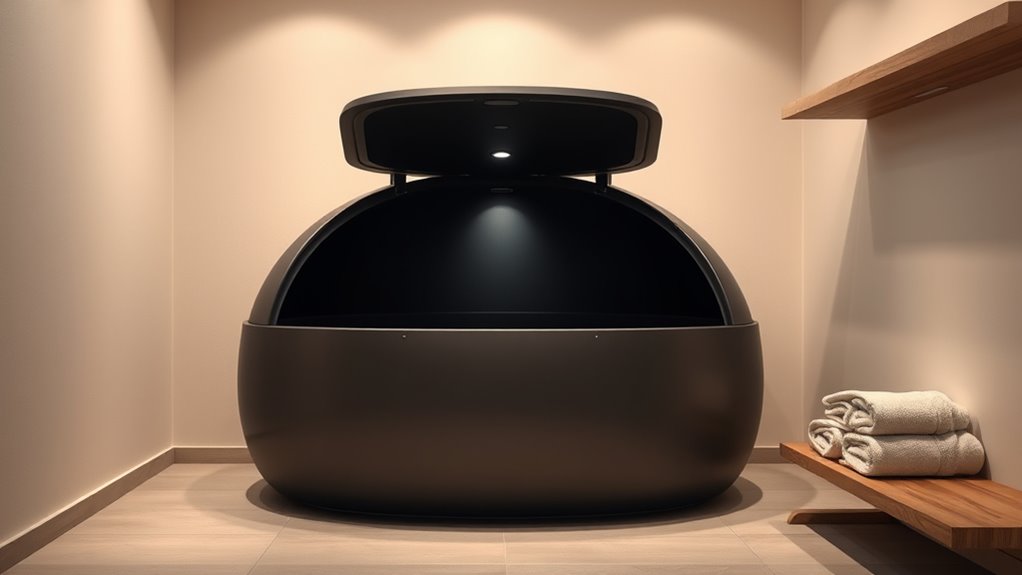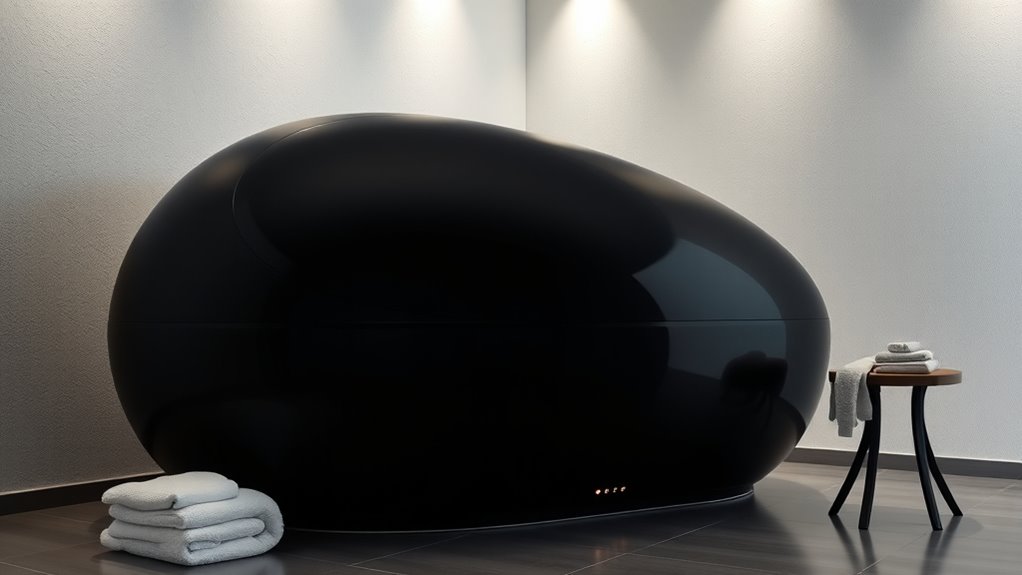When you use a sensory deprivation tank, you’ll enter a quiet, dark environment filled with warm, buoyant saltwater, designed to minimize external stimuli. This helps your brain relax, promoting deep meditation, mental clarity, and emotional calm. You’ll feel weightless and free from outside distractions, often experiencing reduced stress and anxiety. As you settle in, you may notice your thoughts drifting effortlessly. If you keep exploring, you’ll discover how this calming environment can benefit your mind and body even further.
Key Takeaways
- The experience involves floating in a dark, silent, saltwater-filled tank for 60-90 minutes, promoting deep relaxation.
- External stimuli like light and noise are minimized, allowing your brain to enter meditative and introspective states.
- You’ll feel weightless due to buoyancy, helping to reduce physical tension and mental clutter.
- Many users report increased mental clarity, emotional stability, and stress relief during and after sessions.
- The environment fosters mindfulness and self-awareness, making it easier to relax and reconnect with inner calm.

Sensory deprivation tanks, also known as isolation tanks or float tanks, are immersive environments designed to minimize external stimuli. When you step into one, you enter a quiet, dark space filled with warm, buoyant saltwater that supports your body effortlessly. Many people seek out this experience for its float therapy benefits, which include deep relaxation, stress relief, and mental clarity. As you lie back and close your eyes, the absence of external noise and light allows your mind and body to unwind in ways hard to achieve elsewhere. This environment encourages a meditative state, making it easier for you to focus inward and experience meditation benefits more profoundly.
During your session, you’ll notice that your sense of gravity fades away as the water’s buoyancy supports you completely. With sensory input reduced, your brain enters a unique state similar to deep meditation, where thoughts can drift freely without interruption. This heightened sense of calm often leads to a significant reduction in anxiety and mental clutter. Many users report feeling refreshed and more centered afterward, with improved mental clarity and emotional stability. The experience can feel like a reset button for your mind, helping you process stress and emotional tension more effectively.
Float therapy sessions typically last between 60 to 90 minutes, giving you ample time to settle in and fully immerse yourself. As you float effortlessly, your body relaxes, and your nervous system can reset, which is especially beneficial if you deal with chronic stress or physical discomfort. The quiet environment fosters a space for introspection and self-awareness, which can be challenging to achieve in everyday life. This makes sensory deprivation tanks a powerful tool for exploring meditation benefits in a unique, sensory-limited setting. Research indicates that the environment of a sensory deprivation tank can enhance meditative states and promote mental well-being.
Many first-timers find that the experience is surprisingly easy to adapt to, thanks to the calming environment and supportive water temperature. You’re encouraged to let go of expectations and simply enjoy the sensation of weightlessness and silence. Over time, regular float therapy sessions can enhance your ability to meditate, improve your sleep quality, and boost overall mental resilience. Whether you’re seeking stress relief, enhanced focus, or a meditative escape, sensory deprivation tanks offer a distinctive way to reconnect with your inner calm and experience the mental health benefits of deep relaxation and mindfulness.
Frequently Asked Questions
How Long Does a Typical Sensory Deprivation Session Last?
A typical sensory deprivation session lasts about 60 to 90 minutes. During this time, you’ll float in a float tank, experiencing the benefits of sensory deprivation techniques like deep relaxation and mental clarity. Many find that this duration allows enough time to unwind and meditate without feeling overstimulated. Whether you’re seeking stress relief or enhanced creativity, this length is ideal for experiencing the full benefits of float tank benefits.
Are There Any Medical Conditions That Prevent Tank Use?
You should know that medical contraindications might prevent you from using sensory deprivation tanks. Conditions like severe heart issues, epilepsy, or skin infections could pose safety risks. Always check with your healthcare provider before trying it, as safety precautions are vital. If you have any medical concerns, it’s best to discuss them first to ensure a safe and relaxing experience.
What Should I Wear During the Session?
When it comes to clothing choices for your session, comfort considerations are key. Wear minimal, tight-fitting swimwear or none at all if allowed, as this helps maintain the tank’s environment and ensures you feel relaxed. Avoid heavy or restrictive clothing, and check with the facility if you’re unsure about what’s appropriate. The goal is to make your experience as comfortable and peaceful as possible, so choose what feels best for you.
Can I Bring Music or Headphones Into the Tank?
Think of your sensory deprivation tank as a silent symphony, where music preferences can either enhance or disrupt your experience. You can bring headphones, but make sure they’re safe and waterproof to prevent damage. Choose lightweight, comfortable options that fit securely. Keep in mind, the goal is to relax and disconnect, so if music becomes a distraction, it’s best to enjoy the serenity without it.
How Often Should I Practice Sensory Deprivation Therapy?
You should practice sensory deprivation therapy based on your goals and comfort level, typically once or twice a week. Regular sessions can enhance mental health benefits like stress reduction and emotional clarity. Always follow safety precautions, such as limiting session length and consulting a healthcare provider if you have health concerns. Consistency helps maximize benefits, but listen to your body to avoid overstimulation or discomfort.
Conclusion
Now that you know what to expect, diving into a sensory deprivation tank can be a truly eye-opening experience. It’s normal to feel a bit uneasy at first, but don’t worry—you’ll soon find it’s a chance to clear your mind and reconnect with yourself. Remember, sometimes you have to face the storm to see the sunshine. Embrace the journey, and you might just discover a new level of calm and clarity waiting for you inside.









